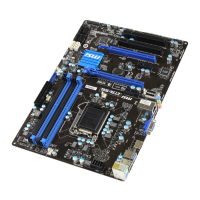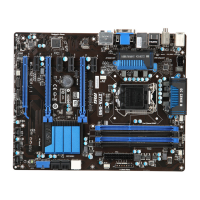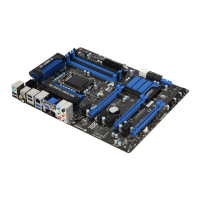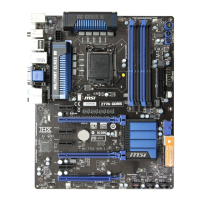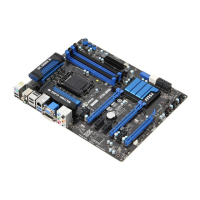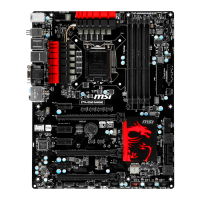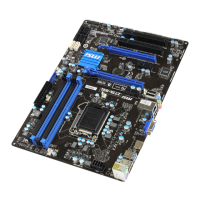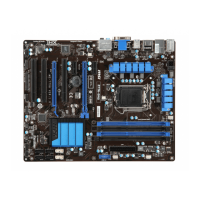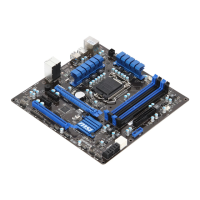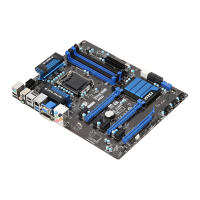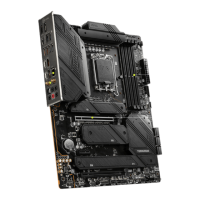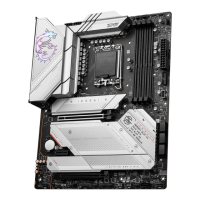Do you have a question about the MSI Z77A-G43 GAMING and is the answer not in the manual?
Basic legal notices and brand acknowledgments for the manual.
Information on obtaining help and essential safety guidelines for system operation.
Statements on FCC, CE, and other regional certifications for the device.
Guidelines for battery handling and proper disposal of electronic waste (WEEE).
Lists items included in the motherboard box and optional extras available.
Critical safety and handling instructions before system assembly to prevent damage.
Detailed technical specifications of the motherboard, including chipset and memory support.
Overview of physical ports and expansion slots on the motherboard.
Detailed descriptions of rear I/O ports, including display and audio connectors.
Step-by-step guide for installing the Central Processing Unit and its cooling solution.
Instructions for installing the motherboard into the chassis and connecting power supplies.
Guide to installing RAM modules and setting up Dual-Channel memory configuration.
Information on installing discrete graphics cards and configuring AMD CrossFire.
Explanation of various internal header connections like SATA, USB, and front panel headers.
Procedures for resetting BIOS settings and installing essential system drivers.
How to access the UEFI BIOS and a description of its main interface layout.
Details on system status display and explanation of primary BIOS menu options.
Explains keyboard hotkeys and mouse controls for navigating within the BIOS.
Configuration options related to system date, time, and SATA device status.
Configuration options for PCI, ACPI power management, and integrated peripherals.
SATA mode configuration and settings for integrated graphics options.
Settings for USB, COM, LPT ports, and fan/temperature monitoring.
Settings for Intel Smart Connect, EuP, Windows 8, and Fast Boot features.
Configuration for wake-up events, secure boot, and boot device support.
Procedures for saving, discarding, or restoring BIOS settings to defaults.
Detailed settings for CPU, DRAM, and integrated graphics overclocking.
Energy-saving configurations and CPU power management options.
Using utilities like HDD Backup, Live Update, and M-Flash for system management.
Configuring administrator/user passwords, USB keys, and chassis intrusion detection.
Overview of audio features and instructions for using the HD Audio Manager.
How the system detects plugged-in audio devices and prompts for configuration.
Diagrams showing default connections for 2-channel to 8-channel audio speaker setups.
Explanation of RAID concepts and the different supported RAID levels (0, 1, 5, 10).
How to access and use the Intel Rapid Storage Technology Option ROM for disk management.
Step-by-step instructions for creating, deleting, and resetting RAID volumes.
Guide for installing Intel RAID drivers during Windows XP/7 operating system setup.
Procedures for dealing with RAID arrays when drives fail or become disconnected.
Instructions for configuring SSD caching to enhance system performance.
Manually synchronizing SSD cache data with hard drives to prevent data loss.
Instructions for installing Windows XP in IDE or AHCI storage controller modes.
Overview of Intel Small Business Advantage and required operating systems and permissions.
Steps for software installation and initial setup of the Intel SBA control panel.
Setting up security passwords and accessing the built-in help features.
Basic legal notices and brand acknowledgments for the manual.
Information on obtaining help and essential safety guidelines for system operation.
Statements on FCC, CE, and other regional certifications for the device.
Guidelines for battery handling and proper disposal of electronic waste (WEEE).
Lists items included in the motherboard box and optional extras available.
Critical safety and handling instructions before system assembly to prevent damage.
Detailed technical specifications of the motherboard, including chipset and memory support.
Overview of physical ports and expansion slots on the motherboard.
Detailed descriptions of rear I/O ports, including display and audio connectors.
Step-by-step guide for installing the Central Processing Unit and its cooling solution.
Instructions for installing the motherboard into the chassis and connecting power supplies.
Guide to installing RAM modules and setting up Dual-Channel memory configuration.
Information on installing discrete graphics cards and configuring AMD CrossFire.
Explanation of various internal header connections like SATA, USB, and front panel headers.
Procedures for resetting BIOS settings and installing essential system drivers.
How to access the UEFI BIOS and a description of its main interface layout.
Details on system status display and explanation of primary BIOS menu options.
Explains keyboard hotkeys and mouse controls for navigating within the BIOS.
Configuration options related to system date, time, and SATA device status.
Configuration options for PCI, ACPI power management, and integrated peripherals.
SATA mode configuration and settings for integrated graphics options.
Settings for USB, COM, LPT ports, and fan/temperature monitoring.
Settings for Intel Smart Connect, EuP, Windows 8, and Fast Boot features.
Configuration for wake-up events, secure boot, and boot device support.
Procedures for saving, discarding, or restoring BIOS settings to defaults.
Detailed settings for CPU, DRAM, and integrated graphics overclocking.
Energy-saving configurations and CPU power management options.
Using utilities like HDD Backup, Live Update, and M-Flash for system management.
Configuring administrator/user passwords, USB keys, and chassis intrusion detection.
Overview of audio features and instructions for using the HD Audio Manager.
How the system detects plugged-in audio devices and prompts for configuration.
Diagrams showing default connections for 2-channel to 8-channel audio speaker setups.
Explanation of RAID concepts and the different supported RAID levels (0, 1, 5, 10).
How to access and use the Intel Rapid Storage Technology Option ROM for disk management.
Step-by-step instructions for creating, deleting, and resetting RAID volumes.
Guide for installing Intel RAID drivers during Windows XP/7 operating system setup.
Procedures for dealing with RAID arrays when drives fail or become disconnected.
Instructions for configuring SSD caching to enhance system performance.
Manually synchronizing SSD cache data with hard drives to prevent data loss.
Instructions for installing Windows XP in IDE or AHCI storage controller modes.
Overview of Intel Small Business Advantage and required operating systems and permissions.
Steps for software installation and initial setup of the Intel SBA control panel.
Setting up security passwords and accessing the built-in help features.
| Chipset | Intel Z77 |
|---|---|
| Socket | LGA 1155 |
| Form Factor | ATX |
| Max Memory | 32GB |
| PCI Express x16 | 2 |
| PCI Express x1 | 2 |
| SATA 6Gb/s | 2 |
| SATA 3Gb/s | 4 |
| Multi-GPU Support | AMD CrossFireX |
| Memory Slots | 4 |
| Memory Standard | DDR3 1600/1333 |
| RAID Support | RAID 0, 1, 5, 10 |
| USB 3.0 Ports | 4 |
| USB 2.0 Ports | 8 |
| Audio | Realtek ALC892 |
| LAN | Realtek 8111E Gigabit LAN |
| Video Outputs | 1 x HDMI, 1 x DVI, 1 x VGA |
